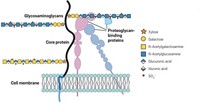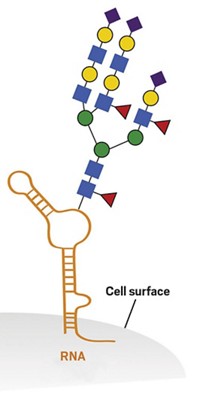Advertisement
Grab your lab coat. Let's get started
Welcome!
Welcome!
Create an account below to get 6 C&EN articles per month, receive newsletters and more - all free.
It seems this is your first time logging in online. Please enter the following information to continue.
As an ACS member you automatically get access to this site. All we need is few more details to create your reading experience.
Not you? Sign in with a different account.
Not you? Sign in with a different account.
ERROR 1
ERROR 1
ERROR 2
ERROR 2
ERROR 2
ERROR 2
ERROR 2
Password and Confirm password must match.
If you have an ACS member number, please enter it here so we can link this account to your membership. (optional)
ERROR 2
ACS values your privacy. By submitting your information, you are gaining access to C&EN and subscribing to our weekly newsletter. We use the information you provide to make your reading experience better, and we will never sell your data to third party members.
RNA
Glyco-RNA found on cell surfaces
Another biological macromolecule has been found to get some sweet additions; researchers say glyco-RNAs could help in immune signaling
by Laura Howes
May 24, 2021

Ribonucleic acid, or RNA, is a hugely important biopolymer. It encodes information, shuttles messages around, and regulates processes inside cells. But while scientists have found that RNA molecules can carry many different types of chemical functionalization, sugar molecules were not part of the RNA language. Until now.
Carolyn Bertozzi at Stanford University and colleagues (Cell 2021, DOI: 10.1016/j.cell.2021.04.023) report that RNA molecules can be decked with sugar molecules and position themselves in cell membranes, sticking out into the surroundings. Early evidence suggests they could be there to signal the immune system, the researchers say.
Max Crispin, a glycobiologist at the University of Southampton, describes the findings as “extraordinary.” He says it “adds to the complexity of extracellular RNA and opens up so many research questions.”
At its simplest, glycosylation is the addition of carbohydrates to a molecule, and in biology, it has become increasingly recognized for its roles in regulating life’s processes. Cells glycosylate proteins and lipids, in some cases as a way to mark that the molecules have been checked—a form of cellular quality control. Glycosylation also can be a signal between cells and can change the stability or folding of proteins.
When RNA biologist Ryan Flynn joined Bertozzi’s lab as a postdoctoral researcher, he wanted to learn about glycans. He suggested they go looking for RNA-glycan conjugates. It was, says Bertozzi, “quite a radical proposal.”
After failing to find evidence of glycosylation of RNA with a common glycosylating sugar, O-linked β-N-acetylglucosamine, Flynn expanded his sights to look for glycosylation by other sugars. When took a step back, he says, he noticed that one sugar in particular kept giving a powerful signal of being bound to RNA: acylated N-azidoacetylmannosamine. That wasn’t what either Flynn or Bertozzi expected because the sugar is typically added to secretory and cell surface molecules—which RNA molecules typically are not—in the endoplasmic reticulum and golgi—where RNA is not usually found. Cue a year of searching for a contaminant or another explanation for the presence of this sugar binding to RNA. “In the end,” Bertozzi says, “we couldn’t shoot it down.”
The team first published their findings in a preprint, ahead of peer review, in 2019 (BioRxiv DOI: 10.1101/787614). The informal feedback from readers of the preprint and, later, suggestions from peer reviewers led to even more experiments. Flynn found that the glycans were on the cell surface and enriched in sialic acid. The team then determined that these glyco-RNA structures bound members of a family of receptors, called Siglecs, that are involved in immune signaling. “It was stunning,” recalls Bertozzi. These glyco-RNAs are specific for two receptors, Siglec-11 and Siglec-14, which implies the glyco-RNAs have defined roles, Bertozzi suggests. It would have been less interesting, she adds, if the binding had been indiscriminate across Siglecs.
Laura Kiessling, an expert in glycans at the Massachusetts Institute of Technology, says the work “could really transform how we think about what glycosylation does, and clearly that’s very exciting.” She points out there is still a lot to learn, including what chemistry links the RNA and the carbohydrate parts together, where on the RNA this happens, and whether an enzyme is responsible for this reaction.
Bertozzi and Flynn, who is now at Harvard University, agree these are just some of the questions they still want to answer. Bertozzi says her money is on this being the start of a whole new chapter of glycobiology and RNA biology. And that has a lot of researchers very interested. “I’m really looking forward to following this story,” Kiessling says.





Join the conversation
Contact the reporter
Submit a Letter to the Editor for publication
Engage with us on Twitter